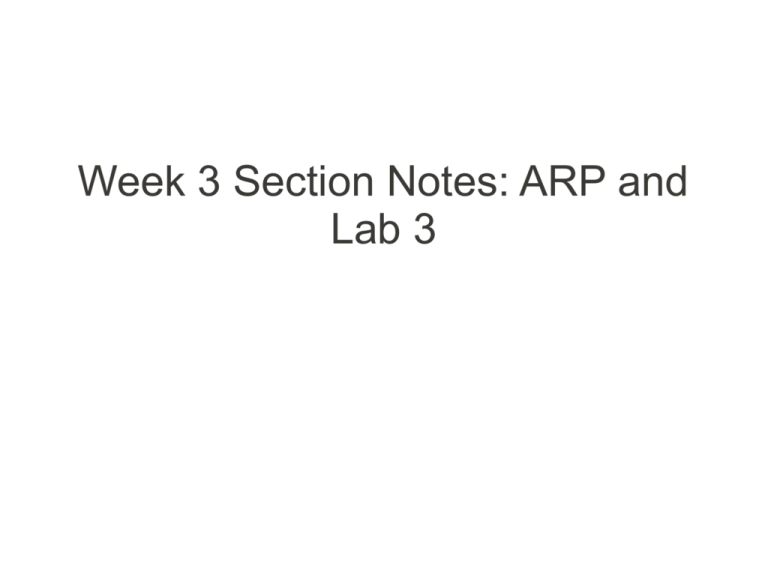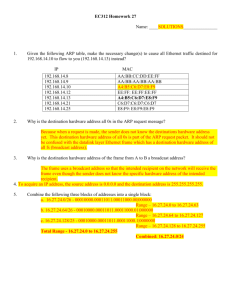Week 3 Section Notes: ARP and Lab 3
advertisement

Week 3 Section Notes: ARP and Lab 3 Overview ● High-level concepts from the week relevant to Lab 3 ● VNS/Setting up Lab 3 ● Where to start in Lab 3 ● Advice and hints ● Questions IP Addresses ● ● Each end host on the Internet is assigned an IP address. To send a packet to another host on the Internet, you must stamp the packet with the destination host's IP address*. Question: Is this IP address fixed? Question: Is this IP address fixed? No. If I plug my computer into an Ethernet jack in Boston, I will receive a different IP than if I plug into Stanford's network. Why? Routing ● ● IP addresses contain information that routers use to determine how to forward a packet. Basic logic: a router that matches the second bit of an IP address is “closer” to the destination than a router that matches the first bit. Simplified Example Advertises for: 18.243.1.0/30 B 18.243.1.0 18.243.1.1 18.243.1.2 18.243.1.3 C Default link: 0.0.0.0/0 A Simplified Example Advertises for: 18.243.1.0/30 B 18.243.1.0 18.243.1.1 18.243.1.2 18.243.1.3 C Default link: 0.0.0.0/0 A IP Addr Subnet Next Hop 18.243.1.0 255.255.255.252 IPB 0.0.0.0 0.0.0.0 IPC Longest Prefix Match ● Bitwise and the packet's destination with all subnets in the routing table: Xi = (Packet Dest IP) & (Subneti) ● Forward to next-hop of entry n with largest IP address that equals Xn . Simplified Example Advertises for: 18.243.1.0/30 B 18.243.1.0 18.243.1.1 18.243.1.2 18.243.1.3 C Default link: 0.0.0.0/0 A IP Addr Subnet Next Hop 18.243.1.0 255.255.255.252 IPB 0.0.0.0 0.0.0.0 IPC ● How do routers know where the next-hop is (IP A and IPB in figure)? Address Resolution Protocol ● ● Maps next-hop IP address to which link-layer address to matches that IP. Basics. When have next-hop IP address: ● ● ● Check if know corresponding link-layer address. If don't, broadcast on link layer interfaces an ARP request for the IP address. Listen for ARP responses, and route accordingly. Overview ● High-level concepts from the week relevant to Lab 3 ● VNS/Setting up Lab 3 ● Where to start in Lab 3 ● Advice and hints ● Questions VNS/Setting Up Lab 3 ● Read ALL the instructions before beginning. VNS/Setting Up Lab 3 ● ● ● Read ALL the instructions before beginning. You must test and your labs on the myth machines. Copy the auth_key file from /usr/class/cs144/lab3_10au/student_auths/<SUNET_ID@stanfo rd.edu>/auth_key ● to your lab directory VNS/Setting Up Lab 3 ctd. ● Create a routing table file. Example is online. 0.0.0.0 172.24.74.11 0.0.0.0 eth0 192.168.128.204 192.168.128.204 255.255.255.255 eth1 192.168.128.206 192.168.128.206 255.255.255.255 eth2 Prefix Next hop Mask Interface VNS/Setting Up Lab 3 ctd. ● Run the command ./sr -u <username> -T '1-router 2-server' -s vns2.stanford.edu -r rtable.vrhost -l logname VNS/Setting Up Lab 3 ctd. ● Run the command ./sr -u <username> -T '1-router 2-server' -s vns2.stanford.edu -r rtable.vrhost -l logname ● If you see an error that says “unauthorized user” ... VNS/Setting Up Lab 3 ctd. ● Run the command ./sr -u <username> -T '1-router 2-server' -s vns2.stanford.edu -r rtable.vrhost -l logname ● If you see an error that says “unauthorized user” … blame the TA. Overview ● High-level concepts from the week relevant to Lab 3 ● VNS/Setting up Lab 3 ● Where to start in Lab 3 ● Advice and hints ● Questions Lab 3 File Overview ● sr_arpcache.h / sr_arpcache.c ● ● Handles all the ARP messaging alluded to previously. sr_router.h / sr_router.c ● Where you receive incoming packets. sr_arpcache ● Pseudocode is included in the sr_arpcache.h file. sr_arpcache ctd. ● ● When you receive a packet, you look for the link-layer address of the next-hop IP. If you don't find it, you: sr_arpcache ctd. ● ● When you receive a packet, you look for the link-layer address of the next-hop IP. If you don't find it, you: ● Queue the packet (call arpcache_queuereq). sr_arpcache ctd. ● ● When you receive a packet, you look for the link-layer address of the next-hop IP. If you don't find it, you: ● Queue the packet (call arpcache_queuereq). ● Broadcast an ARP request. sr_arpcache ctd. ● ● When you receive a packet, you look for the link-layer address of the next-hop IP. If you don't find it, you: ● Queue the packet (call arpcache_queuereq). ● Broadcast an ARP request. You get to write this!!! ● ● Question 1: What layer is ARP? Question 2: When I send a packet on the Internet, does it always get to the destination? ● Question 1: What layer is ARP? It's on the Link Layer. ● Question 2: When I send a packet on the Internet, does it always get to the destination? No! Remember Labs 1 & 2? sr_arpcache ● sr_arpcache.c has a function called sr_arpcache_sweepreqs: ● ● ● Called (roughly) every second. If you haven't received a response for your ARP request in more than a second, send another... Unless, you've requested 5 times. Then send an ICMP error message to all sources. sr_arpcache: Things you'll have to do. ● Broadcast ARP requests. ● Write sr_arpcache_sweepreqs. ● ● ● Build a data structure tracking outstanding ARP requests. Send ICMP error messages when can't find next-hop router. Handle ARP responses. sr_router.c: sr_handlepacket ● ● Where all packets enter your router implementation. Passed in raw Ethernet frames that may represent ● ARP packets ● ICMP packets ● IP packets sr_router.c: sr_handlepacket ● ● Where all packets enter your router implementation. Passed in raw Ethernet frames that may represent ● ARP packets ● ICMP packets ● IP packets You will eventually have to send/generate/modify all of these. Overview ● High-level concepts from the week relevant to Lab 3 ● VNS/Setting up Lab 3 ● Where to start in Lab 3 ● Advice and hints ● Questions Advice and Hints: General ● ● ● ● Start the lab early. Read the documentation carefully before starting. Check out various packet formats linked to in the lab (ICMP, Ethernet, etc.). Come to office hours if you have questions. Advice and Hints: Debugging ● Use Wireshark! Example. ./sr -u <username> -T '1-router 2-server' -s vns2.stanford.edu -r rtable.vrhost -l logname Enable logging, and open logs in wireshark. But Wait! There's more! ● ● What we went over: ● Basic concepts. ● Setting up the lab. ● Where to start. There's more: ● Ping and traceroute. ● FTP/HTTP Extra Questions ● Who remembered when I said VNS gave you 8 IP addresses? How come there aren't that many in the figure? Extra Questions ● What's a multihomed AS? Extra Questions ● Why wouldn't a router always forward a packet to a router advertising a shorter path? Extra Questions ● What is the difference between forwarding and routing? Extra Questions ● What is Nagle's algorithm? Why would people use it?








